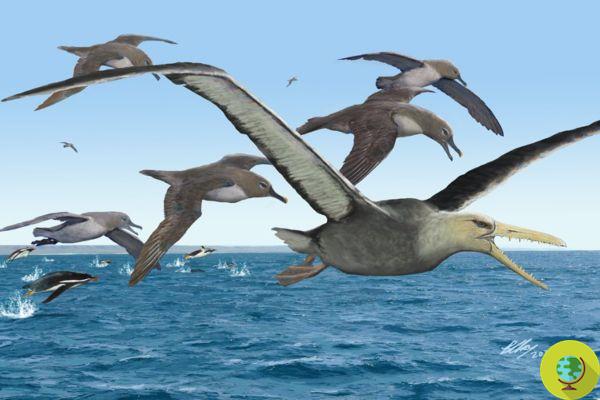
The largest birds that ever lived on Earth lived in Antarctica 50 to 2,5 million years ago. They had a wingspan of over 6 meters
Their wingspan was to be around 6,5 meters. The largest birds that ever lived on Earth lived in Antarctica millions of years ago. This is hypothesized by a new study conducted by scientists at the University of California at Berkeley.
The study, published in Nature, examined some fossil remains recovered from Antarctica in the 80s and represent the giant and oldest specimens of an extinct group of birds that patrolled the southern oceans. According to the study authors, their wingspan could reach 6,4 meters, exceeding the 3,3-meter wingspan of today's largest bird, the wandering albatross.
Called pelagornithids, these creatures crossed Earth's oceans for at least 60 million years. Although a much smaller pelagornitid fossil dates back 62 million years, one just described by the study - a 50-million-year-old portion of a bird's leg - shows that larger pelagornithids arose soon after life. it returned following the mass extinction 65 million years ago, when the relatives of the birds, the dinosaurs, became extinct. A second pelagornitid fossil, part of a jawbone, dates back to about 40 million years ago.
"Our fossil discovery with an estimated wingspan of 5 to 6 meters shows that birds evolved to truly gigantic sizes relatively quickly after the extinction of the dinosaurs and ruled the oceans for millions of years. years, ”said Peter Kloess, a graduate student at the University of California, Berkeley.
The last known pelagornitid dates back to 2,5 million years ago, a period of climate change when the Earth cooled and ice ages began.
Pelagornithidae are known as "bony-toothed" birds because of the bony parts on their jaws that resemble pointed teeth, although they are not true teeth, like those of humans and other mammals. The bony protrusions were covered with a horny material, keratin. Called pseudotes, such parts helped birds catch squid and fish as they hovered over much of Earth's oceans for weeks.
Large flying animals have appeared periodically on Earth, starting with the pterosaurs (reptiles) that lived during the dinosaur era with a wingspan of 10 meters. The pelagornithids came to claim the wingspan record in the Cenozoic, after the mass extinction, and lived until about 2,5 million years ago.
The fossils described by paleontologists are among many collected in the mid-80s from Seymour Island, off the northernmost tip of the Antarctic Peninsula, by teams led by UC Riverside paleontologists. These artifacts were later transferred to the UC Berkeley Museum of Paleontology.
A warm Antarctica was a playground for birds
Fifty million years ago, Antarctica had a much warmer climate during the period known as the Eocene and was not the freezing, hostile continent we know today. Alongside extinct land mammals, such as marsupials and distant relatives of sloths and anteaters, a variety of Antarctic birds occupied the land, sea, and air. Seymour Island, near the northernmost point of the Antarctic Peninsula, has produced a wealth of fossils, including parts of giant birds such as pelagornites and smaller ancestors of today's albatrosses and numerous penguins.
"With a lifestyle probably similar to that of living albatrosses, the extinct giant pelagornites, with their very long pointed wings, would have flown widely over the ancient open seas, which were still to be dominated by whales and seals, in search of squid. , fish and other seafood to be caught with their beaks coated with sharp pseudotes, ”Stidham said. "The big ones are nearly double the size of albatrosses, and these bony-toothed birds would have been formidable predators that have evolved to be at the top of their ecosystem."
Truly amazing creatures.
Sources of reference: University of California Berkeley, Nature
Read also:
- The first blue color in history found in a fossil of a prehistoric bird
- This animal reveals the secret of how dinosaurs became birds
- Hypothesis confirmed! The world's first fossilized feather comes from a wing of the flying dinosaur Archeopteryx
- Insects from prehistoric times were giants


























